Loewe Bild 7.65 Review
Loewe Bild 7.65
Loewe's debut OLED TV is a thing of beauty
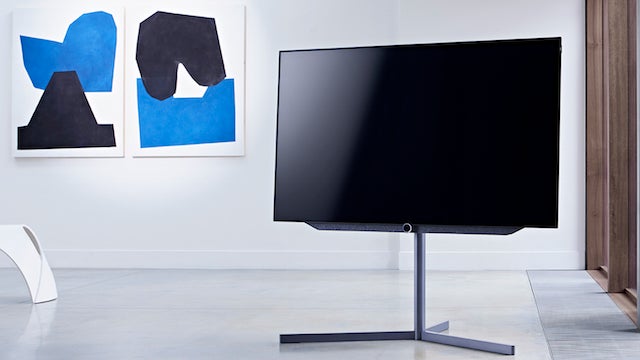
Sections
- Page 1 Loewe Bild 7.65 Review
- Page 2 Picture Quality, Sound and Verdict Review
Verdict
Pros
- Stunning picture quality
- Beautiful motorised design
- Spectacular sound
Cons
- Limited smart features (for now, anyway)
- Occasional noise in background areas
- Expensive versus OLED rivals
Key Specifications
- Review Price: £6490.00
- 65-inch OLED screen
- Native 4K resolution
- Dolby Vision, HDR10 and HLG HDR support
- Loewe's own smart TV system
- Multiple design and external speaker options available
What is the Loewe Bild 7.65?
It takes a lot to stand out in the crowded, tech-filled halls of the annual IFA show in Berlin. Loewe’s Bild 7 TVs, though, made it look easy at IFA 2016.
The German brand’s debut OLED TV range – 55- and 77-inch versions are also available alongside the 65-inch version reviewed here – wowed all who beheld it. This was thanks to the stunning motorised design, gorgeous OLED pictures, Dolby Vision HDR (high dynamic range) support, and powerful integrated audio system.
Many moons may have passed since that startling IFA debut, but if anything the Bild 7.65 makes an even more positive impression now than it did back then.
Related: Loewe Bild 9 hands-on
Loewe Bild 7.65 – Design and Build
It’s just not in Loewe’s DNA to do TV design like everyone else. Actually, it’s not in its business model either; you couldn’t really establish yourself as a premium brand with the prices to match if you weren’t offering something beyond the norm. Even by Loewe’s usually beautiful and opulently built standards, the Bild 7.65 is a bit special.
For starters, there’s a lovely metallic crispness to everything, from the distinctive circular Loewe ‘eye’ LED and IR receiver below the screen, right through to the impressively robust rear panel.
It’s seriously well built. Even though the majority of the screen is insanely thin in that way only OLED technology can manage, I never felt scared of snapping it – which is the worry I’ve had with a number of other super-thin OLED TVs that have come my way.
My review sample arrived on an eminently tasteful black cross-shaped desktop stand. But in typical Loewe style, the Bild 7.65 can be joined by a number of design options, including two floor stands and a multi-joint wall-mounting arm.
What really helps the Bild 7.65 stand out from the OLED crowd is its motorisation. First, provided you select one of the motorised mounting options (including the motorised desktop stand I received for this review), you can rotate the screen left or right at will using the remote, or set pre-determined on-off rotation angles. 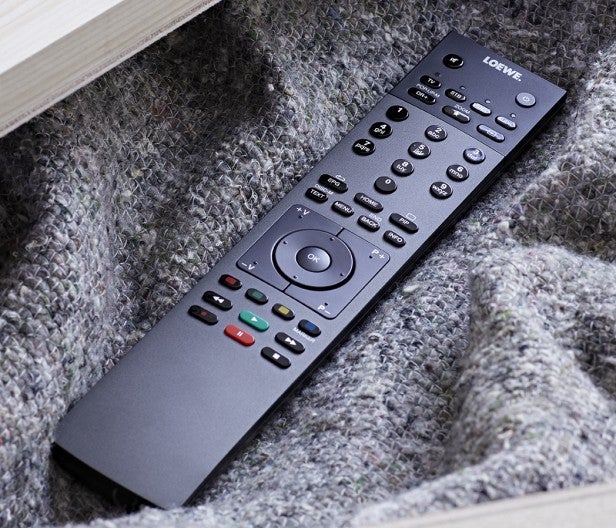
Also, when you turn the TV on, the screen majestically slides a few centimetres upwards to reveal a sleek built-in 120W soundbar.
All of this movement happens smoothly and silently, making you feel like you’ve bought a Bang & Olufsen product without having to pay a B&O price.
The Bild 7.65’s remote control is more of a mixed bag. It’s long, thin, weighty and feels beautiful. But its button layout appears to have little logic behind it, and relies heavily on overly small buttons. It’s certainly not a handset you’ll want to use in a darkened room.
Loewe Bild 7.65 – Setup
It’s clear that Loewe has put some effort into improving the interface of its latest generation of TVs. Mercifully this includes now putting a dedicated Source button on the remote rather than inexplicably requiring you to press the 0 button to get a source list to appear.
Related: Best TVs to Buy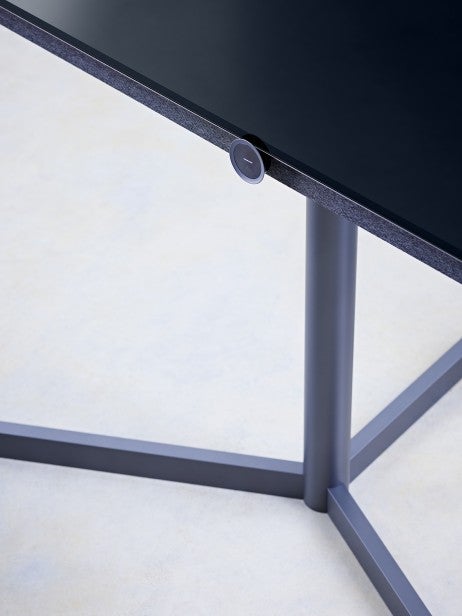
The home screen is better now too, combining favourite TV channel icons and favourite apps in one easy-to-read menu. It’s also exceptionally easy to customise which channel or app icons appear where on this screen, and you can also straightforwardly scroll between different content ‘sections’ (such as TV channels and Apps) via a simple text menu on the left-hand side.
It’s a pity, though, that the picture-adjustment menus are awkward. Text in these menus is crammed into a bar so narrow that words often have to be split in a really ugly fashion. Also, while the set’s use of on-screen feature descriptions is welcome, these descriptions are sometimes written in such poorly translated English that they leave you more rather than less confused.
It doesn’t help that you can only get to Loewe’s video-processing options via the Home menu, and then selecting the Settings icon. If you select the Picture option after pressing the remote’s Menu button instead, for some reason you only get access to a more basic set of picture adjustments.
If this all sounds complicated, that’s because it is. But I’m afraid you will need to learn your way around the menus if you want to get the best pictures from the Bild 7.65.
For instance, you should certainly turn off the noise reduction (DNC) processing when watching 4K content. I’d also recommend setting the Film Quality Improvement feature (Loewe’s motion-compensation system) to its Soft setting, as without it 24p films can exhibit quite noticeable judder, while any higher settings cause distracting side effects. 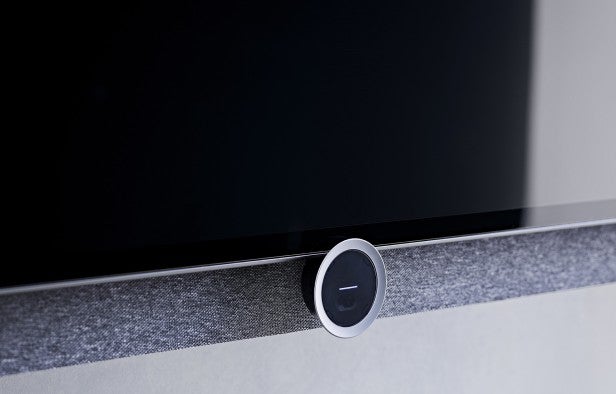
Loewe provides its own Image+ processing system for non-HDR content, but I wouldn’t necessarily recommend that you use it. It gives a slightly more vibrant and ‘contrasty’ image, but the results also look processed.
Also bear in mind when adjusting the picture that you can’t push the brightness higher than its 12 level without the TV’s otherwise awesome black levels starting to take a serious hit.
When viewing HDR content, you can choose from three presets: HDR Dark (optimised for dark rooms), HDR Bright (optimised for bright rooms), and HDR Premium (which uses Loewe’s own ‘algorithm sauce’ to compensate for both motion in the frame and ambient light conditions). You can customise all of these modes as you see fit.
The HDR Dark setting gives the best results out of the box, while your choice between HDR Bright and HDR Premium will likely boil down to whether you prefer the Bright mode’s warmer tones or the Premium mode’s cooler ones.
The Bild 7 carries an auto-calibration mode that runs for almost half an hour, assessing and perfecting the screen’s images based on purely internal factors; it doesn’t take your room conditions into account.
DIY tweakers and custom installers should note that the Bild 7 does not carry nearly so many manual fine-tuning options as the majority of high-end TVs. But the picture quality results you can achieve using the tools that are available are so good that I can’t imagine many buyers missing the lack of fine-tuning too much.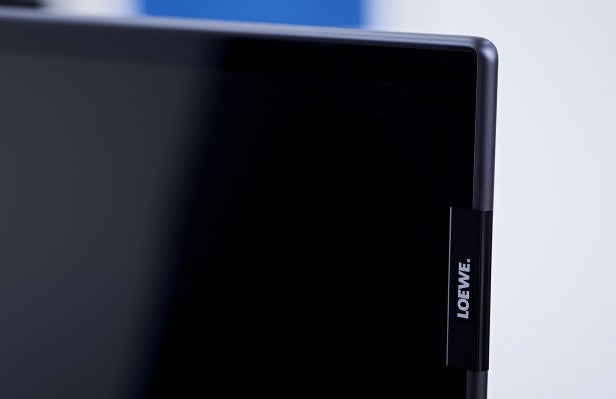
Loewe Bild 7.65 – Features
That the Bild 7.65 is a motorised, designer TV built around one of LG’s latest 4K HDR OLED panels is its most immediate attraction.
Not everyone will be able to afford the high price associated with this premium approach to OLED, of course, and it’s true as well that LG has some pretty spectacular-looking OLED TVs of its own that don’t cost as much. But the motorisation and various design options mean that you can’t fairly say that the Bild 7.65 doesn’t do enough to justify its extra cost.
It’s great to see Loewe deciding to add support for the Dolby Vision HDR platform as well as the industry standard HDR10 platform. Dolby Vision’s use of an extra layer of data providing screens with scene by scene instructions on how to best present the picture has yielded impressive results so far, so there’s no reason to suppose it won’t work great here too.
Dolby Vision sources are currently very limited – especially as the Bild 7.65 does not at the time of writing support Netflix, with its collection of Dolby Vision titles. The first Ultra HD Blu-rays with Dolby Vision on board are due to arrive in June, though, and Loewe assures us that Dolby Vision streaming will be supported soon.
The Bild 7.65’s HDR options also include support via its DVB tuner for the new Hybrid Log Gamma (HLG) platform set to be used by broadcasters in the coming months.
Connections on the Bild 7.65 initially look pretty decent. There are four HDMIs, three USBs, and the usual Wi-Fi and Ethernet. The network ports can stream from DLNA devices as well as providing access to Loewe’s online services.
It turns out, though, that only one of the HDMIs (HDMI4) is a full-bandwidth offering capable of handling the best 4K HDR pictures the AV world currently has to offer.
As usual with Loewe TVs, the Bild 7.65 additionally supports an array of external sound options, such as wireless subwoofers and surround sound speaker systems (with which the speaker in the Bild 7.65 becomes the centre channel).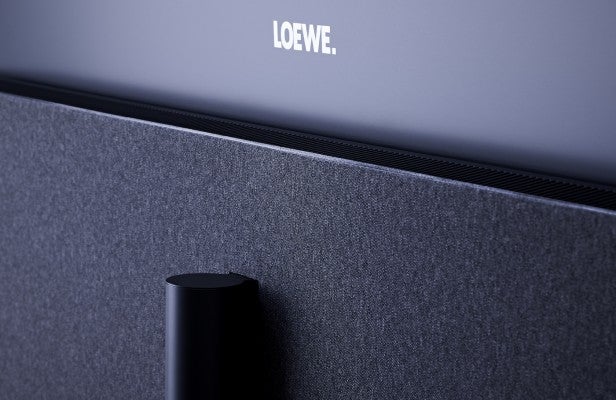
Loewe has also expanded its other wireless connectivity options for the Bild 7.65. For instance, you can stream video from the TV to other Loewe TVs or iOS/Android devices equipped with the Loewe app. Plus there’s Bluetooth support for both music players and headphones.
The Bild 7.65 also boasts another distinctively Loewe feature: DR+. This is an integrated 1TB hard drive onto which you can record direct digital streams from the built-in Freeview HD tuner.
If you’re not already using some sort of external recording box, DR+ is a really great feature; being able to set and watch recordings from within your TV just feels so logical and simple. And before you start shouting that you can record to external USB hard drives with most mid-range or higher TVs these days, the number of people who actually bother to install a USB drive for recording is tiny.
The Bild 7.65’s smart features are all Loewe’s own work – which isn’t necessarily a great thing as it turns out. While I don’t mind the simplicity of the straightforward and easily customisable panel of large instant-access icons, it soon becomes apparent that there really aren’t many apps for UK users to get their teeth into.
Yes, Amazon Video and the BBC iPlayer are present and correct, but particularly noticeable by their absence are Netflix, plus the ITV Hub, All4 and My5 catch up TV platforms. The Amazon app doesn’t offer HDR either, just 4K.
I spoke to Loewe about these issues, and was assured that HDR would be added to Amazon Video in a future firmware update, while the main UK catch up TV platforms are all expected to be available by the end of 2017. Loewe couldn’t offer any firm information on Netflix, though. Instead it pointed to the fact that an imminent software update will upgrade the Bild 7.65’s Graphic User Interface to provide better support for external 3rd-party Netflix-carrying devices such as Apple TV, Roku boxes and Amazon Fire.
The Bild 7.65’s most startling feature is its support for 3D playback. Nearly every other brand has ditched 3D for 2017, including LG with its own OLEDs. But at the time of writing, the Bild 7.65 – created using a Loewe-exclusive panel from LG Display – carries the necessary processing and passive 3D filter (though it doesn’t ship with any passive 3D glasses).
Why did I say ‘at the time of writing’ back there? Because the 3D support for the Bild 7 range will be discontinued at some undetermined point in 2017, when supplies of the 3D panel run out.
In fact, the 77-inch Bild 7 set to arrive in the UK soon won’t have 3D support even at launch. So if you’re a 3D fan out there desperate to get your hands on a high-quality 3D-capable TV this year, I strongly suggest you secure a Bild 7.65 or 55-inch Bild 7.55 as soon as possible – and check that the one you’re getting will definitely still do 3D.
How we test televisions
We test every TV we review thoroughly over an extended period of time. We use industry standard tests to compare features properly. We’ll always tell you what we find. We never, ever, accept money to review a product.

